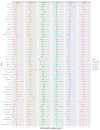Determinants of Diabetes Disease Management, 2011-2019
- PMID: 34442081
- PMCID: PMC8393363
- DOI: 10.3390/healthcare9080944
Determinants of Diabetes Disease Management, 2011-2019
Abstract
This study estimated the effects of Medicaid Expansion, demographics, socioeconomic status (SES), and health status on disease management of diabetes over time. The hypothesis was that the introduction of the ACA and particularly Medicaid Expansion would increase the following dependent variables (all proportions): (1) provider checks of HbA1c, (2) provider checks of feet, (3) provider checks of eyes, (4) patient education, (5) annual physician checks for diabetes, (6) patient self-checks of blood sugar. Data were available from the Behavioral Risk Factor Surveillance System for 2011 to 2019. We filtered the data to include only patients with diagnosed non-gestational diabetes of age 45 or older (n = 510,991 cases prior to weighting). Linear splines modeled Medicaid Expansion based on state of residence as well as implementation status. Descriptive time series plots showed no major changes in proportions of the dependent variables over time. Quasibinomial analysis showed that implementation of Medicaid Expansion had a statistically negative effect on patient self-checks of blood sugar (odds ratio = 0.971, p < 0.001), a statistically positive effect on physician checks of HbA1c (odds ratio = 1.048, p < 0.001), a statistically positive effect on feet checks (odds ratio = 1.021, p < 0.001), and no other significant effects. Evidence of demographic, SES, and health status disparities existed for most of the dependent variables. This finding was especially significant for HbA1c checks by providers. Barriers to achieving better diabetic care remain and require innovative policy interventions.
Keywords: ACA; Medicaid; diabetes; quasibinomial.
Conflict of interest statement
The authors declare no conflict of interests.
Figures







References
-
- Protection P., Act A.C. Patient protection and affordable care act. Public Law. 2010;111:759–762.
-
- Census Health Insurance Coverage in the United States: 2014–2015. [(accessed on 20 July 2021)]; Available online: https://www.census.gov/library/publications/2015/demo/p60-253.html.
-
- Smith J.C., Medalia C. Health Insurance Coverage in the United States: 2013. US Department of Commerce, Economics and Statistics Administration, Bureau; Washington, DC, USA: 2014.
-
- Berchick E.R., Hood E., Barnett J.C. Health Insurance Coverage in the United States: 2018. Department of Commerce; Washington, DC, USA: 2019.
LinkOut - more resources
Full Text Sources

